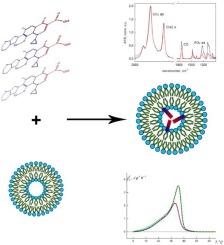当前位置:
X-MOL 学术
›
Chem. Phys. Lipids
›
论文详情
Our official English website, www.x-mol.net, welcomes your
feedback! (Note: you will need to create a separate account there.)
Moxifloxacin interacts with lipid bilayer, causing dramatic changes in its structure and phase transitions.
Chemistry and Physics of Lipids ( IF 3.4 ) Pub Date : 2020-02-10 , DOI: 10.1016/j.chemphyslip.2020.104891 Irina M Le-Deygen 1 , Anna A Skuredina 1 , Anastasia S Safronova 1 , Ivan D Yakimov 1 , Ilya M Kolmogorov 1 , Daria M Deygen 1 , Tatiana V Burova 2 , Natalia V Grinberg 2 , Valery Y Grinberg 2 , Elena V Kudryashova 1
Chemistry and Physics of Lipids ( IF 3.4 ) Pub Date : 2020-02-10 , DOI: 10.1016/j.chemphyslip.2020.104891 Irina M Le-Deygen 1 , Anna A Skuredina 1 , Anastasia S Safronova 1 , Ivan D Yakimov 1 , Ilya M Kolmogorov 1 , Daria M Deygen 1 , Tatiana V Burova 2 , Natalia V Grinberg 2 , Valery Y Grinberg 2 , Elena V Kudryashova 1
Affiliation

|
Most drugs besides their intended activity, express undesired side effects, including those with the engagement of cell membrane. Previously, such undesired nonspecific effects on the membrane have been shown for a number of widely used nonsteroidal anti-inflammatory drugs. In this paper, we study the mechanism of interaction between moxifloxacin (Mox), antibacterial drug of broad specificity, with lipid bilayer of the liposomes of various compositions as a model of cell membrane using a combination of spectroscopy methods, including ATR-FTIR spectroscopy, circular dichroism, UV and fluorescence spectroscopy. The fine structure of the moxifloxacin-liposome complex, localization of the drug in bilayer and the main sites of Mox interaction with lipid membrane were determined. Lipid composition of the liposome plays a key role in the interaction with moxifloxacin, drastically affecting the loading efficiency, strength and character of drug binding, lipid phase segregation and phase transition parameters. In case of anionic liposomes composed of dipalmitoylphosphatidylcholine (DPPC) and cardiolipin (CL2-) the electrostatic interaction of negatively charged nitrogen in heterocycle moiety of moxifloxacin with cardiolipin phosphate groups is a crucial factor for stable complex formation. The study of moxifloxacin-liposome complex behavior at phase transition in bilayer by DSC method revealed that in DPPC/CL2- liposomes system two microphases with different content of CL2- coexist and Mox interacts with both of these microphases resulting in the formation of two types of complexes with different structure and phase transition temperature. This binding stabilized the gel-state of the lipid bilayer with increasing the phase transition temperature Tm up to 3-5 °C. A different situation is observed for neutral DPPC liposomes: drug interaction with bilayer results in defects formation and a fluidization effect in lipid bilayer, resulted to decrease the Tm value by 2-4 °C. Moxifloxacin is not firmly binding in the membrane of DPPC and drug releases rapidly.
中文翻译:

莫西沙星与脂质双层相互作用,引起其结构和相变的急剧变化。
大多数药物除了其预期的活性外,还表现出不良的副作用,包括那些与细胞膜结合的副作用。以前,已经对许多广泛使用的非甾体抗炎药显示了对膜的这种不希望的非特异性作用。在本文中,我们结合包括ATR-FTIR光谱在内的多种光谱方法,研究了广谱特异性抗菌药物莫西沙星(Mox)与各种成分脂质体的脂质双层作为细胞膜模型之间的相互作用机理,圆二色性,紫外和荧光光谱。确定了莫西沙星-脂质体复合物的精细结构,药物在双层中的定位以及Mox与脂质膜相互作用的主要部位。脂质体的脂质组成在与莫西沙星的相互作用中起着关键作用,极大地影响了装载效率,药物结合的强度和特性,脂质相分离和相变参数。在由二棕榈酰磷脂酰胆碱(DPPC)和心磷脂(CL2-)组成的阴离子脂质体的情况下,莫西沙星杂环部分中带负电荷的氮与心磷脂磷酸基团的静电相互作用是稳定复合物形成的关键因素。用DSC方法研究莫西沙星-脂质体复合物在双层相变过程中的行为,发现在DPPC / CL2-脂质体系统中,两个不同CL2-含量的微相共存,并且Mox与这两个微相相互作用,导致形成两种类型的具有不同结构和相变温度的配合物。随着相变温度Tm升高至3-5°C,这种结合稳定了脂质双层的凝胶状态。对于中性DPPC脂质体,观察到了不同的情况:与双层的药物相互作用导致缺陷形成和脂质双层中的流化作用,导致Tm值降低2-4°C。莫西沙星在DPPC膜中未牢固结合,药物迅速释放。随着相变温度Tm升高至3-5°C,这种结合稳定了脂质双层的凝胶状态。对于中性DPPC脂质体,观察到了不同的情况:与双层的药物相互作用导致缺陷形成和脂质双层中的流化作用,导致Tm值降低2-4°C。莫西沙星在DPPC膜中未牢固结合,药物释放迅速。随着相变温度Tm升高至3-5°C,这种结合稳定了脂质双层的凝胶状态。对于中性DPPC脂质体,观察到了不同的情况:与双层的药物相互作用导致缺陷形成和脂质双层中的流化作用,导致Tm值降低2-4°C。莫西沙星在DPPC膜中未牢固结合,药物释放迅速。
更新日期:2020-02-10
中文翻译:

莫西沙星与脂质双层相互作用,引起其结构和相变的急剧变化。
大多数药物除了其预期的活性外,还表现出不良的副作用,包括那些与细胞膜结合的副作用。以前,已经对许多广泛使用的非甾体抗炎药显示了对膜的这种不希望的非特异性作用。在本文中,我们结合包括ATR-FTIR光谱在内的多种光谱方法,研究了广谱特异性抗菌药物莫西沙星(Mox)与各种成分脂质体的脂质双层作为细胞膜模型之间的相互作用机理,圆二色性,紫外和荧光光谱。确定了莫西沙星-脂质体复合物的精细结构,药物在双层中的定位以及Mox与脂质膜相互作用的主要部位。脂质体的脂质组成在与莫西沙星的相互作用中起着关键作用,极大地影响了装载效率,药物结合的强度和特性,脂质相分离和相变参数。在由二棕榈酰磷脂酰胆碱(DPPC)和心磷脂(CL2-)组成的阴离子脂质体的情况下,莫西沙星杂环部分中带负电荷的氮与心磷脂磷酸基团的静电相互作用是稳定复合物形成的关键因素。用DSC方法研究莫西沙星-脂质体复合物在双层相变过程中的行为,发现在DPPC / CL2-脂质体系统中,两个不同CL2-含量的微相共存,并且Mox与这两个微相相互作用,导致形成两种类型的具有不同结构和相变温度的配合物。随着相变温度Tm升高至3-5°C,这种结合稳定了脂质双层的凝胶状态。对于中性DPPC脂质体,观察到了不同的情况:与双层的药物相互作用导致缺陷形成和脂质双层中的流化作用,导致Tm值降低2-4°C。莫西沙星在DPPC膜中未牢固结合,药物迅速释放。随着相变温度Tm升高至3-5°C,这种结合稳定了脂质双层的凝胶状态。对于中性DPPC脂质体,观察到了不同的情况:与双层的药物相互作用导致缺陷形成和脂质双层中的流化作用,导致Tm值降低2-4°C。莫西沙星在DPPC膜中未牢固结合,药物释放迅速。随着相变温度Tm升高至3-5°C,这种结合稳定了脂质双层的凝胶状态。对于中性DPPC脂质体,观察到了不同的情况:与双层的药物相互作用导致缺陷形成和脂质双层中的流化作用,导致Tm值降低2-4°C。莫西沙星在DPPC膜中未牢固结合,药物释放迅速。











































 京公网安备 11010802027423号
京公网安备 11010802027423号